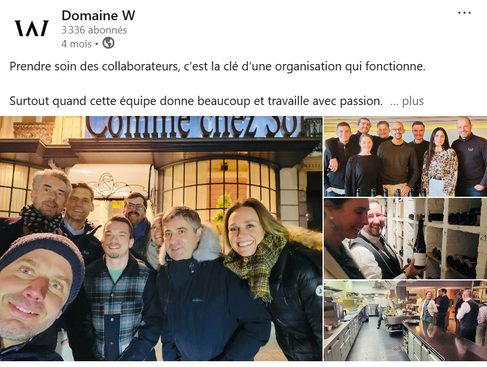Dimitri Vander Heyden (Domaine W): “Gourmet restaurants are our ambassadors”
- François Remy

- Jul 2
- 6 min read
In the vast wine-growing landscape, a Belgian gem is shining brighter and brighter: Domaine W. From their Tubize "oasis," on the biodynamically cultivated family farm, Sophie Wautier and Dimitri Vander Heyden produce a remarkable Crémant de Wallonie. It's even won multiple awards. A model of unparalleled vineyard that the founders dream of seeing "modestly but virtuously" spread throughout Europe. Interview.

40,000 bottles per year, 1,800 active member-investors including 300 companies, 17 Michelin-starred restaurants, Belgium's leading wine bank, 2 happy co-founders, 0 herbicides or insecticides... The inventory is already prodigious, even though it's not even exhaustive. This sums up the spirit of modest excellence that emanates from this modernized farmhouse, built on the path of the vineyards in Tubize.
Domaine W welcomes us without anyone reminding us that its blanc de blanc was recently crowned the best Chardonnay in the world. Additional letters of nobility for this "young" Crémant de Wallonie, as required by the protected designation of origin, which stands up to comparison with the great references of France, Spain, or Italy.
Inspired in particular by the adage "there is no economic success without social success," learned from the lips of a former CEO of Danone, where he climbed the ladder over fifteen years from the shelves to the position of Country Manager for Austria and Slovenia, Dimitri Vander Heyden explains to us with natural simplicity the mission that his wife Sophie and he have been pursuing since 2016: to reinvent viticulture. Nothing less.
"We are proving that another viticulture is possible"
The Belgian wine sector has undergone remarkable growth in recent years. Production exceeded 3 million liters for the first time in 2022, nearly half of which was sparkling wine. At the same time, the number of Belgian winegrowers has continued to grow. Last year, the country had 321 registered winegrowers, including professionals and passionate amateurs. These producers cultivate a planted area of nearly 1,000 hectares (958 ha), with a predominance of grape varieties dedicated to sparkling wines, produced on more than 100 estates.
To stand out, Dimitri and Sophie developed the "W model," an innovative viticulture focused on quality and sustainability. A major challenge in itself, which the co-founders did not hesitate to intensify by imposing the strictest specifications: Demeter-certified biodynamics. Zero herbicides or insecticides, planting more than 1,000 trees, installing beehives, cultivating flower meadows to attract vine auxiliaries, producing biomass (miscanthus) for energy autonomy, leaf stripping and harvesting by hand, and using draft horses to avoid compacting the soil...
These commendable efforts still needed to result in a high-quality product and a sustainable business model. The Brut de Brabant producer then developed a strategy focused on a "unique experience" through direct and exclusive sales channels. An interview with Domaine W's managing director, Dimitri Vander Heyden.
Gondola Foodservice - A viticulture that respects the land and people, a business model driven by committed members, you inevitably reap what you sow. You're clearly the one who achieves success. And do gourmet restaurants play a particular role in Domaine W's success?
Dimitri Vander Heyden - The model isn't perfect yet. (laughs) But we're demonstrating that it's possible to do it without chemical agents, by revitalizing the soil and offering ultra-high-quality products. We're not the ones saying this; these are blind tastings. And, indeed, gourmet restaurants are important. They represent 50% of our turnover. And for them, it's their job to taste, and we're not cheap. So if they offer us for tasting at their place, it's not because we're cheap, it's because the product behind it lives up to its promises.
Then, they come to harvest with us. We recently had the entire Comme Chez Soi team come to work. They participated in everything, they pressed with us, and pressing is physical.
- There's no better way to get a front row seat to manufacturing.
Obviously. And, in fact, we created a special bond with the sommeliers because we realized that they didn't have a perfect understanding of what goes on behind the scenes. They master the appellations, they have a highly developed palate, etc., but on the other hand, wine production is very little part of their training. For them, harvesting, using the press, and also tasting the wines at different stages of the process: the base wines that have just been fermented, then the wines in refermentation in bottles lying on slats, then the finished wine disgorged with different dosages...
In a way, they also train with us and understand all the added value that our product has. Because when they see the harvest, they see that it's a gamble, it's careful, it's done by hand, it's delicate, the pressing is slow, it's gentle, it takes time. What they pressed there before, in fact, will only be marketed 3 years later in their restaurant. And they see that there is no added product. At that moment, you create more than customers, you create ambassadors.
- Ambassadors able to set the price for a specific product?
Yes, we focused more on haute cuisine because, obviously, these customers are able to pay the price for a quality product. But also, because they find something there, they also win in the equation. These restaurants can offer a product that can't be found anywhere else. Our product isn't available at wine shops, so it really creates something unique.
Obviously, when a sommelier in a gourmet restaurant offers you "a little Belgian gem, Crémant de Wallonie, biodynamic, et cetera" alongside high-end champagnes, the experience it creates is interesting. Because restaurants can offer this somewhat exclusive experience to their customers, who perhaps prefer not to taste the same champagne for the umpteenth time. They seek this sophistication, especially with what they have at their table.
- The cost of the bet and the benefit of originality?
There you go. With an interesting price-quality ratio too. However, you could say we're expensive. But a biodynamic champagne today costs 50 euros a bottle. Our price is 37 euros, which is expensive in itself, but it's still cheaper than champagne. If we look at the quality level in supermarkets today, a bottle of champagne costs 30 or 35 euros. But in Champagne alone, 200 million bottles are produced. The Belgians remain among the largest consumers in the world per capita. But the champagne market is starting to suffer. Belgium shipped just under 8 million bottles last year. In the wine markets, crémants continue to grow. With a consumer who loves bubbles, and in a market segment that is growing, we feel like we're sailing in the "Blue Ocean."
- But no Brut de Brabant in stores; you reserve your bottles exclusively for members of your wine club, to compensate their investments in kind. And then, is it reserved for your gourmet customers?
Exactly. We work directly with gourmet restaurants; it's a luxury. It allows us to limit, let's say, the loss of margin, and we manage to offer them a price comparable to a fine champagne because there's no middleman, no wholesaler who would take 20 or 30%. But we will be especially competitive on the experience side. For us, when we enter a restaurant, what's even more interesting is that the sommeliers often change and move to a new establishment. And they reintroduce us in a new restaurant. It's a bit of a wild card. While the old establishment keeps us, new consumers can discover us. For now, our marketing is carried out exclusively this way.
- So another viticulture is feasible and profitable. How can we change the world from a small Walloon farm?
This is the new chapter of our ten-year vision, how to spread our model. We don't want to fall into a vision of infinite growth. On the other hand, we realize that today we have 40 hectares of land, on which there are 8 hectares of vines. Philosophically, technically, it is indeed our oasis, as we call it here. But how can we support the spread of this model? In Belgium, but especially elsewhere. We would like our model to inspire other actors, for them to take it up, improve it, adapt it to their reality, and replicate it. And for others to replicate it again, and so on.
We have the strength of having an extremely engaged and large community—1,800 loyal and involved members—that allows us to finance all of this. And that allows us today to have French people come to see us, people from Champagne. Gone are the days when we asked, "Do we know how to make champagne in Belgium?" The answer is yes, we even know how to make better champagne than most other champagnes. We won't be able to beat the big Champagne houses, at least not right away.















